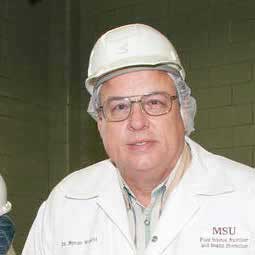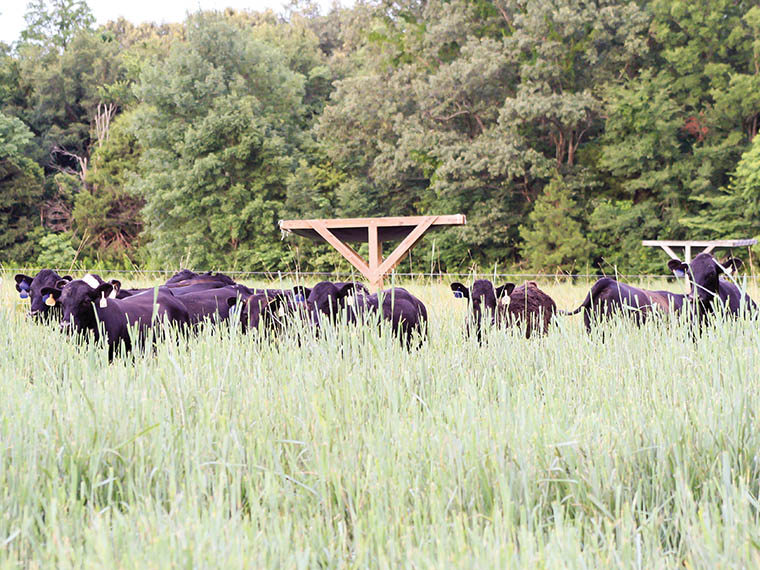The information presented on this page may be dated. It may refer to situations which have changed or people who are no longer affiliated with the university. It is archived as part of Mississippi State University's history.
The old adage, the grass is always greener on the other side of the fence, may have a new twist when it comes to cattle foraging. As consumer interests for forage-finished beef increases in the United States, scientists in the Mississippi Agricultural and Forestry Experiment Station are studying different forages and the effects on beef quality and taste.
"Consumers are interested in forage-raised beef as a leaner, healthier option and producers are looking for the best forages for their cattle," said Wes Schilling, professor in the Department of Food Science, Nutrition and Health Promotion. "In this study, we wanted to determine the quality of beef from cattle that were fed native warm-season grasses and either forage-finished or grain-finished."
Scientists conducted two separate studies at the Experiment Station's Prairie Research Unit, examining the quality of beef foraged on native grasses and bermudagrass.
Bermudagrass is the most common grass used to graze cattle in the southern United States due to its large biomass production. However, the prolific grass has little wildlife quality compared to native warm-season grasses.
Indigenous to the southeastern United States, native warm-season grasses such as Indiangrass and bluestem provide superior wildlife habitat, however, there is minimal research on the quality of beef which graze on this forage.
Seventy-two steers were randomly allotted to nine pasture plots with three different forage treatments that included bermudagrass, Indiangrass, and a mix of native warm-season grasses. Cattle were foraged-finished on tall fescue.
"Cattle about six to seven months old grazed on these forages until winter and then were fed sudangrass hay/roughage and supplement during the winter," Schilling said. "Cattle were grazed on tall fescue the following spring and summer until they reached the target harvest weight."
Cattle were harvested and transported to the Meat Science Laboratory where scientists graded the meat following USDA guidelines and prepared cuts of meat for the research.
Scientists simulated retail display conditions by placing cut steaks in Styrofoam trays, overwrapping with clear film and stored under lights in refrigerated conditions for nine days. Testing was conducted every three days during the storage time.
"We tested numerous variables in the steaks including percentage of moisture, fat, protein and collagen," Schilling said. "Color, pH, cooking loss, tenderness and consumer acceptability were also tested, among many other variables."
Additionally, eight panelists were trained to evaluate steaks based on aroma, flavor intensity and numerous other factors according to standards established by the American Meat Science Association.
"Our trained panelists evaluated rib (grass-finished) and strip loin steaks (grain-finished) from the respective projects during training sessions and then the actual sensory studies," said Byron Williams, associate extension and research professor in the Department of Food Science, Nutrition and Health Promotion.
Of the variables tested by scientists in the laboratory, they found that fat percentage was greater in steaks from the Indiangrass treatment compared to steaks from the mixed native warm-season grass. Moisture percentage was greater in steaks from the bermudagrass treatment compared to the Indiangrass treatment. No other differences in composition existed among the treatments.
In a similar study that evaluated cattle which were grain-finished, there was a large difference in fat percentage and only a slight difference in moisture percentage, Williams added.
Overall, the steaks from all the treatments did not differ in color, pH and instrumental tenderness. Consumers rated beef steaks from all the treatments favorably indicating that beef from forage-finished cattle, fed native warm-season grass during the stocker phase and then finished on tall fescue was acceptable to consumers.
"The overall results obtained in this study indicates that forage-finished beef was acceptable among the consumers and had a storage period of six days under simulated retail display conditions," Williams said. "Since native warm-season grasses are abundant in the southeastern United States and provide excellent wildlife habitat for ground nesting birds and bobwhite quail, farmers could consider these grasses for their cattle foraging."
Nearly 85 percent of cattle in the U.S. are fed on grass in the stocker phase and then finished on grain which shortens the time to market. However, increased grain prices coupled with consumer demand have triggered the need for alternate feeding practices which can be utilized by farmers to reduce feeding costs.
"Since meat quality is influenced by numerous factors including diet, this study set out to determine if there was a difference in the quality of meat and consumer acceptability in cattle fed native warm-season grasses versus bermudagrass," Schilling added.
In the grain-finished study, steaks from the bermudagrass treatment had greater fat content and lower protein and moisture percentages compared to steaks from the Indiangrass and mixed native warm-season grasses.
"In both studies, we found that native warm-season grasses are an acceptable forage for beef cattle during the stocker phase, producing a lean, high protein product with positive consumer acceptability," Schilling added.
Behind the Science

Wes Schilling
Professor
Education: B.S.; M.S.; Ph.D.; Food Science and Technology, Virginia Polytechnic Institute and State University; M.S., Statistics, Virginia Polytechnic Institute and State University
Years At MSU: 1.5
Focus: Muscle food processing; sensory science, and food chemistry
Passion At Work: I enjoy training students to conduct research, setting up experimental design and analyzing data. I also enjoy helping students understand their potential and develop their interpersonal skills.

J. Byron Williams
Associate Extension and Research Professor
Education: B.S., Animal Science; M.S., Meat Science; Ph.D., Food Science and Technology, Mississippi State University
Years At MSU: 19
Focus: Muscle foods
Passion At Work: I enjoy solving problems for the industry and helping people be more profitable and productive in their food businesses.

